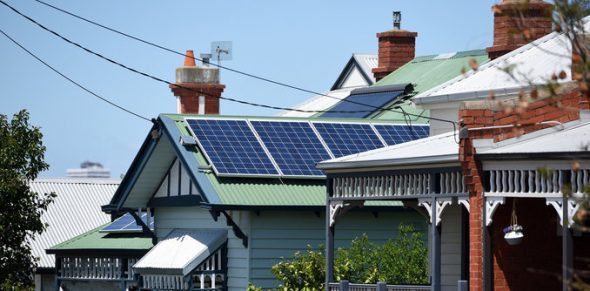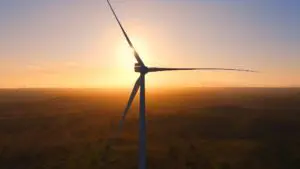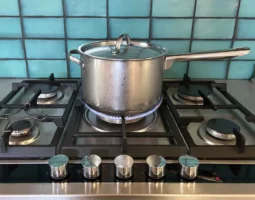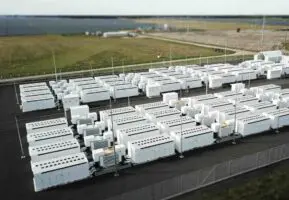Australia’s total solar power capacity has reached 6GW and is expected to double over the next few years as Australian households continue to invest in rooftop panels to reduce electricity bills, and the large-scale solar sector takes off after years of promise.
The latest industry analysis on installed capacity – released by the Australian Photovoltaic Institute – shows that rooftop solar capacity has now reached 5.6GW and large-scale solar capacity is now at 496MW, and growing fast.
 The leading state in rooftop solar remains Queensland, with 1.72GW of rooftop solar – that makes it, as we reported here, bigger than the state’s largest coal generator. NSW and Victoria also have more than 1GW of rooftop solar capacity, with South Australia having the highest penetration (32 per cent) among residential dwellings.
The leading state in rooftop solar remains Queensland, with 1.72GW of rooftop solar – that makes it, as we reported here, bigger than the state’s largest coal generator. NSW and Victoria also have more than 1GW of rooftop solar capacity, with South Australia having the highest penetration (32 per cent) among residential dwellings.
As of April 2017, there was a total of 1.67 million PV installations in Australia, covering 21 per cent of suitable rooftops, which is the highest penetration of rooftop solar in the world. In total, these solar installations collectively generate 8,400 gigawatt hours of electricity each year, which meets approximately 3.3 per cent of Australian demand.
The data suggests that the rate of installation of rooftop solar is also accelerating. After establishing a record March quarter, the rate of installations for the year to date is up significantly in all the major states.
Interestingly, the biggest growth is coming from Western Australia, which has installed 43MW so far this year, outstripping Victoria, as locals prepare for the likely imminent removal of the state-based subsidy that has hidden the true cost of electricity from consumers.
The subsidy accounts for around one-third of the cost of power, and the new Labor government has flagged its removal to help it address the state’s soaring budget deficit. That is likely to make rooftop solar even more attractive – which explains the 71 per cent jump in installations so far this year.
The Sunwiz data – sourced from the Clean Energy Regulator – also highlights the solar hotspots in Australia, including the towns and suburbs where households without rooftop solar are in the minority.
For example, two-thirds of all households in Baldivis in Western Australia and Elimbah in Queensland now have rooftop solar. (See our story here on sister site One Step Off The Grid).
“With batteries now readily available on the market, many people are taking this opportunity to install both solar and batteries – or to upgrade the size of their existing solar systems,” says Sunwiz analyst Warwick Johnston. “The price of solar has dropped low enough, and power prices are rising high enough, for this to make economic sense for many commercial operators, too.”
APVI chair Dr Renate Egan said Australian homeowners, commercial businesses and large-scale solar farms had all contributed to an extra 1GW of solar being added to the grid over the past year.
“Solar power now makes up 11 percent of our country’s total electricity generation capacity with more solar added to the system in 2016 than any other fuel type,” Egan said in a statement.
By 2020, the total is expected to double again, with Sunwiz forecasting at least 800MW of rooftop solar to be installed this year and following years, and Bloomberg New Energy Finance forecasting more than 3,000MW of large scale solar to meet the legislated renewable energy target as solar matches wind power on costs (see graph above).
 By 2040, the amount of solar capacity could have risen 10-fold from its current levels. BNEF, as this graph to the right illustrates, is predicting 33GW of rooftop solar and 27GW of large-scale solar as solar power becomes the primary source of electricity generation in Australia.
By 2040, the amount of solar capacity could have risen 10-fold from its current levels. BNEF, as this graph to the right illustrates, is predicting 33GW of rooftop solar and 27GW of large-scale solar as solar power becomes the primary source of electricity generation in Australia.
It could increase even further, if plans to create “solar export fuels”, using renewables such as solar and wind to create hydrogen and then “green ammonia” to supply Asian economies such as South Korea and Japan, hungry for clean fuels to replace imported coal and LNG.
In any case, by 2040 the nature of the grid will have changed dramatically, and will have become more “distributed” – as predicted by the new head of the Australian Energy Market Operator Audrey Zibelman.
The key features will be localised and flexible generation. Batteries – and BNEF predicts there will be at least 15GW of them – will provide a large amount of flexibility, but so too will other forms of flexible generation, including demand response.
Coal capacity might have reduced to just 5GW by that time, with gas also taking a role in delivering flexible generation, although this will largely depend on the future cost of batteries, with some already suggesting that the combined cost of large-scale solar and battery storage is already beating gas, and could be “well under” $100/MWh – and current wholesale electricity prices – within a few years.
Developers of large-scale solar projects already report fierce competition for power purchase agreements, with bidding under $70/MWh in some cases and heading towards $60/MWh.
Those developers that have the equity behind them, and access to low-cost finance, are choosing to go the “merchant” route, where they can tap into high wholesale electricity prices and – for a few years more at least – high prices for large scale renewable energy certificates.
Consumers – both household and business – are facing the opposite problem, landed with not just the increased costs of wholesale power, but the high price of transport (networks) and retail margins. Hence their huge interest in rooftop solar and storage.









